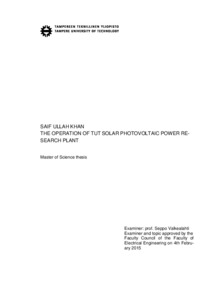The Operation of TUT Solar Photovoltaic Power Research Plant
Khan, Saif Ullah (2016)
Khan, Saif Ullah
2016
Master's Degree Programme in Electrical Engineering
Tieto- ja sähkötekniikan tiedekunta - Faculty of Computing and Electrical Engineering
This publication is copyrighted. You may download, display and print it for Your own personal use. Commercial use is prohibited.
Hyväksymispäivämäärä
2016-12-07
Julkaisun pysyvä osoite on
https://urn.fi/URN:NBN:fi:tty-201611234752
https://urn.fi/URN:NBN:fi:tty-201611234752
Tiivistelmä
Photovoltaic power production has a large potential when it comes to converting solar energy into electrical energy. This is the reason that the number of photovoltaic power plants in Finland is on the rise. This increasing trend makes it very essential to study the effects of various environmental factors on the operation of photovoltaic power plants. Factors such as ambient temperature, wind speed, diffuse radiation, global radiation and humidity are very important to the operation of photovoltaic power plants. These factors directly or indirectly effect the power production and therefore determine the feasibility of a photovoltaic power plant in a particular environment.
Therefore, it was important to study the profiles for the above mentioned environmental factors from the research power plant located in Tampere University of Technology, Tampere, Finland. The annual and seasonal profiles from January 2014 to December 2014 were studied and analyzed. The measurements were taken using the state of the art data acquisition system installed at the test facility. The effect on module temperature and irradiance was also studied.
It was concluded from the results that humidity remained highest during the winter months because of heavy cloud cover. This cloud cover was also responsible for the fact that global solar radiation was almost equal to diffused solar radiation during winter time. Thus, for maximum production and working efficiency it was essential to ensure that the diffuse radiation component was also harvested by the photovoltaic power plants. Wind speed more or less remained the same over the course of a year with the highest value during the autumn period in months of September and October. The maximum average value recorded for ambient temperature was during the summer period. The study revealed that for the maximum working efficiency of a photovoltaic power plant the behavior of various environmental factors such as wind speed, global and diffuse radiation, humidity and ambient temperature must be taken into account.
Therefore, it was important to study the profiles for the above mentioned environmental factors from the research power plant located in Tampere University of Technology, Tampere, Finland. The annual and seasonal profiles from January 2014 to December 2014 were studied and analyzed. The measurements were taken using the state of the art data acquisition system installed at the test facility. The effect on module temperature and irradiance was also studied.
It was concluded from the results that humidity remained highest during the winter months because of heavy cloud cover. This cloud cover was also responsible for the fact that global solar radiation was almost equal to diffused solar radiation during winter time. Thus, for maximum production and working efficiency it was essential to ensure that the diffuse radiation component was also harvested by the photovoltaic power plants. Wind speed more or less remained the same over the course of a year with the highest value during the autumn period in months of September and October. The maximum average value recorded for ambient temperature was during the summer period. The study revealed that for the maximum working efficiency of a photovoltaic power plant the behavior of various environmental factors such as wind speed, global and diffuse radiation, humidity and ambient temperature must be taken into account.
